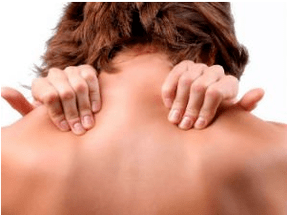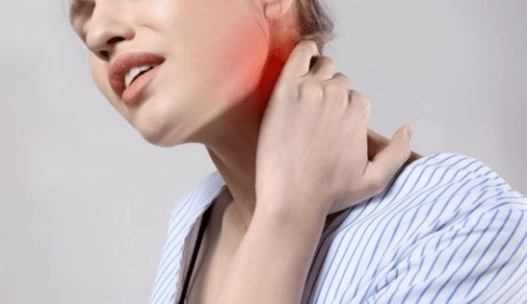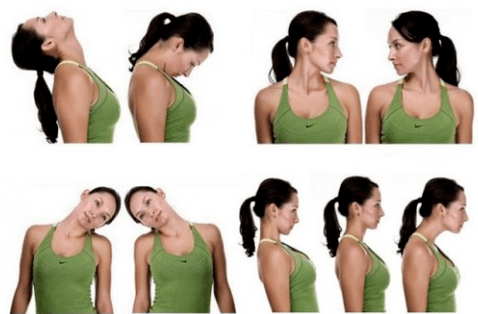Few modern people have not heard of osteochondrosis.Most of them repeatedly experienced the symptoms of this disease.The widespread use of the disease is connected by prolonged sitting on the computer, a passive way of life, malnutrition, etc.Cervical spine osteochondrosis is manifested by pain, weakening of muscles, limitation of mobility and a whole complex of other symptoms.

Do not ignore the signs of osteochondrosis, because the sooner you start treatment, the faster you get rid of the disease.In the early stages, conservative therapy is performed: taking medications, exercise therapy, physiotherapy, massage, etc., when complications and the destruction of bone skin structure, an operation is prescribed.
What is it
Neck osteochondrosis is a pathology found only in people.The animals do not suffer from him.This is due to the vertical location of the spine.In this position, the vertebrae tighten, which leads to the fact that intervertebral discs are gradually destroyed.
The cervical department consists of 7 vertebrae, which are separated from each other on records.This column segment is quite mobile, which is why it is one of the most vulnerable sections in the spine spine.The weaker connection in the cervical region is the intervertebral disc, which mainly reflects degenerative-distribution changes.
The prevalence of cervical osteochondrosis is also explained by a weak muscle corset in the neck.In addition, small vertebrae are placed in this area, they have a different structure and fit very strongly.This is why even a small load in the neck can cause its displacement, as well as compression of blood vessels and nerve branches.By squeezing the vertebral artery, which is placed inside the spine in this area, dangerous complications occur.
Cervical spine osteochondrosis threatens a protrusion (displacement of a pulp nucleus without damage to the external bark) and hernias of the disc.These formations compress nerve beams, vessels.
Due to degenerative changes in intervertebral discs, the likelihood of bone growth (osteophytes) in joint locations increases.For this reason, neuro-vascular formations are reduced between the spinal canal.
Reference.According to medical statistics, people over 35 suffer more frequently from cervical osteochondrosis.Although there is now a rejuvenation of the pathology, which usually develops in 20 -year patients.This is due to the lifestyle and malnutrition mainly sedentary.
Doctors identified 4 stages of pathology:
- 1 degree - the cartilage between the vertebrae begins to collapse.At this stage, the disease erased the symptoms.Unfortunately, patients do not notice them.
- 2 degrees - Under the pressure of the vertebrae, the height of the disc is reduced, the integrity of its external membrane is violated.At this stage, protrusion may appear.Pain appears, neck mobility is limited, perhaps a violation of face sensitivity.
- 3 degrees - protrusions are transformed into hernias that compress blood vessels and muscles.In addition to pain, pain in the back of the head, dizziness is observed.
- The 4 -degree osteophytes that stabilize the vertebrae, but squeezed the nerve fibers.The pain does not disappear, the rigidity of the movements occurs, the neighboring vertebrae are damaged, the neurological symptoms appear.
It is important to start treatment at 1 to 2 stages in order to avoid serious complications that can only be fixed with a surgical method.
Reasons
Schop osteochondrosis is a complex and prolonged process that can occur under the influence of many negative factors.
For example, in the elderly, the disease is associated with age -related changes in the body.Next, degenerative-distribution changes emerge as a result of a violation of local blood circulation, metabolic processes and the weakening of immunity.
However, doctors identified the main causes of cervical osteochondrosis:
- Incorrect posture.
- The curvature of the spine of the spine.
- Cervical segment lesions.
- Excessive weight.
- Great physical job.
- Long term sitting on the computer.
- Passive lifestyle.
- Violation of metabolic processes.
- Frequent neck hypothermia.
- Incorrect organization of the vacancy (very soft mattress, high pillow).
- Frequent tensions, chronic fatigue.
- Congenital pathologies of the store structure.
- Autoimmune diseases that cause cartilage degeneration.
- Infections.
- Characteristics of body parts, for example, a very long or short neck.
Under the influence of these factors, intervertebral structures begin to collapse, bone tissues, nerve curls and blood vessels are damaged.
Symptoms
The clinical picture for cervical spine osteochondrosis is diverse.For this reason, it is difficult for patients to understand what is happening to them.The first manifestations of the disease are discarded for overwork.And after the appearance of pronounced symptoms, they are in a hurry for the doctor, but in this case irreversible changes are already present and the structure of the cervical region will no longer be possible.

The main symptoms of cervical spine osteochondrosis:
- Painful sensations in the neck, shoulders.
- Weakening of the muscles surrounding the affected segment of the spine.
- Excessive scenario of sweat.
- Violation of the sensitivity of the upper ends.
- Movement coordination disorders.
- Head pain.
- Dizziness (dizziness).
- Hearing disorders, vision.
- Bench heels, etc.
The nature of headache in osteochondrosis is different: paroxysmal, constant, pulsating, bland.This symptom manifests itself due to the spasm of brain vessels, compression of nerve beams of the cervical spine and increased intracranial pressure.
With cervical spine osteochondrosis, pain does not always appear in the cervical segment area, it can spread to the shoulders, hands.The discomfort can occur after sleep, clear movement, tension of the neck, for example, with cough or sneezing.
With coastal osteochondrosis, pressure peaks are observed, depending on the time of day, constant hypertension is not loaded for pathology.Generally, with increasing pressure, the following manifestations are observed: head pain, hand pain, cervical numbness.Pressure falls are often observed after nervous or muscle stress, long -term stay in an uncomfortable position.
Cervical osteochondrosis syndromes
With cervical spine osteochondrosis, several syndromes are observed (typical conditions that are accompanied by characteristic symptoms).Its manifestation depends on which nerve branches and blood vessels are damaged.
Cervical osteochondrosis syndromes:
- Vertebral artery - occurs as a result of compression or irritation of the artery that nourishes the brain.So the patient suffers from hearing disorders, vision, dizziness, drop drops, migraines, etc.
- CARDIAL - It is developed by compressing nerve beams that innervate the diaphragm or thoracic muscle.Then an ardent chest pain, shortness of breath, weakness, heartbeat appears.
- Hypertension caused by vein compression, which is why blood exit is disturbed from the head.Then intracranial pressure increases, the patient suffers from cherry, nausea, vomiting.
- Cervical migraines-occorted due to compression of the nerves surrounding the vertebral artery.Then a painful pain of the migraine on the back of the head appears.The attack lasts about 10 hours and is usually accompanied by the eruption of vomiting.
- Soreshcock is the most common symptom complex for cervical spine osteochondrosis.It is caused by the compression of one of the nerve beams in the vertebrae of the cervical segment.With a violation of conductivity, 1 - 2 roots of the cervical vertebra, sensitivity is disturbed or pain in the back of the head appears.In case of damage to 3 pairs, the tongue is numb, the area behind the ears is difficult for a person to chew food.The inflammation of 4 pairs of root is accompanied by collar pain, hiccups, difficulty in swallowing.If the conductivity of 5 to 8 pairs of nerve beams is broken, it is difficult for the patient to move his hands.
Reference.Often, cervical spine osteochondrosis manifests immediately with various symptoms by complexes, the diagnosis is difficult.Therefore, do not understand yourself, it is better to contact experts.
Making a diagnosis
If you do not know what to do when suspicious symptoms appear, it is better to contact the therapist immediately.If necessary, the doctor will direct you to an orthopedist, a neurologist.
In the diagnostic research, the following instrumental studies are used:
- Radiography.
- Imagine computer or magnetic resonance.
All studies above provide certain information about the cervical region.For example, x -ray, CT, RM are used to identify pathological changes in the spine structure.Electromyography allows to evaluate the condition of nerve beams.
With the help of the radiography, performed in different projections, you can detect the accumulation of calcium salts, a decrease in the height of the cartilage between the vertebrae, the deformation of the store, the presence of bone growth etc.
Treatment
The therapy of cervical spine osteochondrosis should be complex.The decision to choose the methodology is taken by the doctor taking into account the stage, the form of the disease, the severity of the symptoms.
The treatment of cervical spine osteochondrosis is long and complex.Pathology can be unlikely to be completely healed, especially when it comes to elderly patients.However, it is quite possible to interrupt degenerative dystrophic disorders in the cervical segment at any stage.
In the early stages of the disease, conservative methods are used: medicines, therapeutic exercises, physiotherapeutic procedures, massage, orthopedic devices.Most methods above can be used at home.
In 3-4 stages, which is accompanied by the destruction not only of the cartilage, but also from the bodies of the vertebrae, surgery may be required.
To get rid of pain, inflammation, relax tense muscles, the following medications will help improve the condition of cartilage tissue:
- Anesthesia.With intense pain, you can help yourself by accepting a painkillers pill.For the same purpose, NSAIDs are used, which allow you not only to deal with pain and inflammation.
- Steroids interrupt the inflammatory process and pain.For this purpose, medications based on hydrocortisone, prednisolone, dexamethasone in the form of tablets or ointments are used.
- Muslaxantes help relax the muscles around the damaged area.For this purpose, solutions for parenteral administration based on glycerol or glymidazole are used.They normalize muscle tone and weaken pain syndrome.
- Spasmoolithics help combat pain and muscle spasms.
- Vitamins accelerate the restoration of the nervous system.For this purpose, medicines are taken based on the elements of group B, A, C, D, E. vitamin-mineral complexes are quite effective.
Reference.If pain syndrome is too serious and oral painkillers do not help, the doctor may prescribe a Novocaine blockade.Injections using anesthetic or steroid solutions are placed directly in the focus of the pathology.This procedure can only be performed by an experienced specialist.
In complex therapy, creams, gels, ointments with anti -inflammatory analgesic effect, heating and analgesic.
To relieve patients' condition, improve their physical form, prescribe therapeutic gymnastics.Exercises help strengthen muscles around the neck, improve metabolic processes, accelerate blood circulation and weaken the load in the weakened spine.
Particularly popular among Oshop gymnastics in the salon using special simulators.However, if you wish, you can handle at home.

LFK complex for cervical osteochondrosis:
- Small your head on your shoulder, repair your head for 30 seconds and repeat the movement in the other direction.
- Include your head forward, trying to touch your chin on your chest, then get up and a little forward.
- Lower your head a little back, turn right and then the left shoulder.
- Press your left shoulder with your right hand, lift your elbow a little.Then turn your head to the right, take a long time, feeling muscle tension.
- This exercise is performed as the third, only during the turn of the head, lift your arms over your head and adhered to them.
- With your knees, spread it sideways, trying to connect the shoulder blades, while understanding the chin up.Then you will elaborate the thoracic region.
- Get up, lower your hands, stretch your neck forward, trying to touch your chin on your shoulder.
Before class, you need to make a joint -and take a shower to relax your muscles.After running the complex, run the stretching.
You can treat neck osteochondrosis with physical therapy:
- Uhf.
- Laser therapy.
- Magnetotherapy.
- Electrophoresis with medicines, etc.
Magnetotherapy facilitates inflammation, pain.UHF and laser treatment accelerates metabolism in the affected area, it helps eliminate swelling.Thanks to electrophoresis, drugs penetrate the focus of inflammation through the skin, where they immediately manifest their effect.
With the help of massage, muscle tone is normalized, blood flow to the damaged area is accelerated, trophic tissue is improved.After passing the course, which usually consists of 10 procedures, the development of degenerative-distribution processes at the cervical spine stops.
At home, you can use an applicator - this is a plastic device with many peaks.You need to go to the device or apply it in the affected area.The applicator helps weaken pain, relaxes muscles, improves blood circulation and motor activity.
With complex treatment, the patient may get rid of neck osteochondrosis forever.However, this is possible if the disease was detected at 1 stage.In other cases, comprehensive events will help interrupt the development of pathology.
Cardy degeneration of the cervical region (chondrosis)
Many people believe that chondrosis and osteochondrosis are a disease.However, this opinion is erroneous.In the first disease, only the cartilage of the vertebrae is damaged and, with the second, the degenerative changes apply to bone tissues.That is, chondrosis is the first stage of osteochondrosis.
Condrosis in the cervical region develops when the intervertebral disc processes are interrupted.Then collagen fibers are replaced by useless fibrous fabric, hyaline cartilage is calculated, becomes less elastic.Its height decreases, which is why the vertebral function is disturbed.
Cervical Condrosis has the following signs:
- Fast fatigue of the muscles surrounding the store.
- Violation of posture.
- Discomfort or periodically light pain in the affected area.
- Restriction of neck mobility.
The disease is detected by accident during X -ray or magnetic resonance imaging.
Condrosis Treatment
In the first illness, doctors prescribe NSAIDs and chondroprotectors.In addition, the patient should avoid excessive physical exertion or prolonged session.It is recommended to perform therapeutic gymnastics, eat right, abandon bad habits.
Additional treatment methods include massage, manual therapy.In addition, physiotherapeutic procedures are shown, for example, electrophoresis, ultraviolet irradiation, amplipulster, diadima therapy, balneotherapy and mud treatment.Acupuncture proved its effectiveness in treatment.
The main conclusions
Cervical spine osteochondrosis is an insidious disease that manifests itself by various symptoms.The patient does not always understand what is really happening to him.And when pronounced pain, it is in a hurry to the doctor, however, this sign indicates the presence of degenerative-distribution changes in the cervical segment.In this case, it will not be possible to restore the condition of the spine.Then treatment is performed, which helps to interrupt the development of pathology and avoid serious consequences.Osteochondrosis therapy is a complex and long process that requires patience, organization.After eliminating pain and inflammation, the patient should regularly perform exercise therapy, participate in massage, physiotherapeutic procedures, use orthopedic devices, eat right, abandon bad habits.It is important to bring a healthy lifestyle, observe moderate physical activity, control weight, monitor posture.Only in this case can you stop the pathology and live a complete life.


















